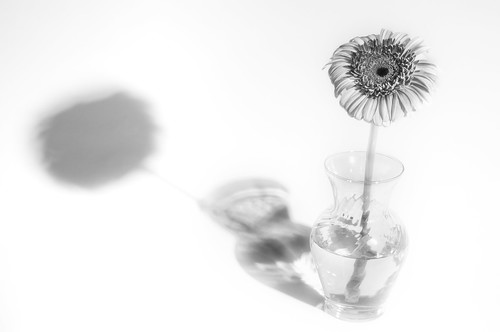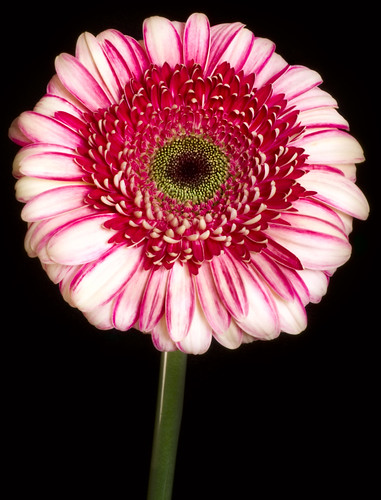
Remembrance of Things Past, photo by Harold Davis. View this image larger.
This is a high-key image, in the sense that it is predominantly overexposed from the perspective of a smack-dab-in-the-middle “proper” exposure histogram. In other words, the exposure histogram is right-biased to a considerable degree.
In addition, the photograph features a largely white background, typical of high-key imagery.
When shooting something like this, I bracket like crazy—so I have a number of choices when I process the RAW captures. I can even pick and choose passages from several of the bracketed exposures if it seems like a good idea (it did not in this case).
When I started to process the photo, I considered adding some detail to the shadow “flower”—but everything I tried seemed a bit hokey. So I left the shadow of the flower as what it is, an undifferentiated flower.
This is not a glamour photo of a fresh-cut flower in an elegant crystal vase. The Gerbera is shown below photographed against black in the callow days of its youth.
The flower is past its prime and has already lived a full life. The point of the photo for me is the association of the shadow with memories—so the photo has a spare, elegant, and nostalgic feeling. Appropriate as we face the waning of the year and the dawn of a new decade.
View this image larger.

Osselin
26 Dec 2009If I understood well, you prefere to make a multiraw processing taking different RAWS ( I mean several shots) by a progressive bracketing than make a multiraw processing from just only one RAW ( and then an only shot)multiprocessed as times as you need. When I just finished my first reading of your book I had this doubt in mind.
In short. We get more optimal technical results with a multi-raw taken and processed from several shots or a multi-raw got from an original shot multiprocessed several times in ACR?
Many thanks, Harod. Answer when yo have time for it, please, I know is Christmas Time.